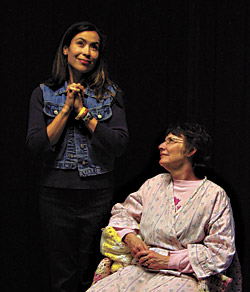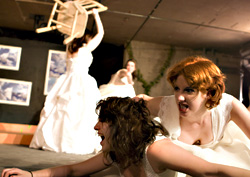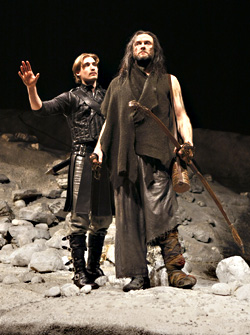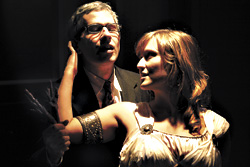LIKE BILBO’S RING, Winnie the Pooh empowers or destroys all who touch him. Pooh wrecked the literary career of his creator, A.A. Milne, and so embittered Milne’s neglected son, Christopher Robin, that the boy spent most of his life a penniless bookseller, declining dime one of Pooh money and refusing to see his rather nasty parents even when his dad was dying of cancer.
Walt Disney was thrilled to acquire rights to Pooh; now his faltering company is addicted to the bear, who generates perhaps one-quarter of Disney’s $25 billion annual revenue. Next month, Disney nemesis Bert Fields and O.J. nemesis Daniel Petrocelli square off in a lawsuit against Disney brought by the ex-Broadway showgirl who owns the original Pooh marketing rights.
A collateral victim of the fracas is the only great artwork in the post-Pooh canon: the literary-criticism satire of Frederick Crews. In 1963, Berkeley English prof Crews penned the legendary The Pooh Perplex, learned essays by fictitious critics that lampooned academic fads: Marxism, New Criticism, Freudianism. Since then, Crews wrote real scholarship and dazzling popular books that treated Freud and the recovered- memory movement like Godzilla treated Tokyo. Meanwhile, Disney made Pooh central to pop culture, and academic culture went barking mad under the influence of Derrida, de Man, and da rest of the postmoderns. When David Duchovny left Yale’s deconstructionist English department to star in The X-Files, he was moving in the direction of normality.
Crews faced two hurdles in writing his new Perplex sequel, Postmodern Pooh (North Point Press, $12), the transcript of a panel discussion at an imaginary convention of the Modern Language Association in which fictitious critics debate 2003 fads like “Zizekian Lacanianism” and “Counterhegemonic Post-Gramscian Marxism.” For one, authorities forbade Crews to use E.H. Shepard’s classic Pooh illustrations—it would be “disrespectful to A.A. Milne and Ernest H. Shepard as well as damaging to the brand.” This was odd, since Disney’s rebranding of Pooh was so distorting that Shepard called it “a complete travesty.” Could Crews do worse? No matter: The book’s parodic prose is colorful enough without Pooh drawings, and the ursine cover image dramatically illustrates what a monster our favorite teddy has become.
Crews’ second challenge was tougher: to do justice to his satiric targets, modern critics so crazy it’s hard for satire to exaggerate their hilariousness. Crews solves the problem by inventing imaginary critics—some based on readily identifiable academic stars—and anchoring their cuckoo lucubrations with quotes and footnotes from actual academic publications. Thus the scholar Das Nuffa Dat (from Calcutta via Eton and Oxford) is Crews’ creation, but when Dat cites Gayatri Chakravorty Spivak on “the post-colonial attempt at the impossible cathexis of place-bound history,” it’s all too real.
Similarly, Carla Gulag, Joe Camel Professor of Child Development at Duke University, is imaginary. But Duke University (endowed by tobacco money) is a real postmodern stronghold whose English department was so bitterly fractious in the ’80s that the dean had to put a botany professor in charge of it. Gulag quotes her Marxist mentor, the real-life literary theorist Frederic Jameson—he famously defended the Nazi writings of Paul de Man and wrote that Heidegger’s Hitler commitment was “morally and aesthetically preferable to apolitical liberalism”—and goes on to note that when Piglet cakes himself in dirt, he’s “reasserting his class identity and [preventing] social castration by the whitening, starching, homogenizing influence of that sylvan soccer mom, Kanga.” The “gynocritic” Sisela Catheter has a more radical feminist view of Kanga, not to mention the “Fire Island-style fireworks” of Pooh: “When Eeyore appears most invitingly available to be sodomized, the abashed Pooh realizes that the requisite tool is missing.” Poor patriarch Pooh! In “The Courage to Squeal,” Dolores Malatesta, a nonexistent Seattle author, cites actual nut-job authorities to support her theory that Piglet’s a victim of Satanic sexual abuse.
THE ONLY TWO faux critics I can identify as being based on real people are right-wing Fundament magazine editor Dudley Cravat III and N. Mack Hobbs, Princeton Trustees’ Portfolio Tracking Stock Professor of English. Cravat growls that if you listen to “the anti-anti-Communist rainbow coalition, our Pilgrim fathers were mere powwow crashers [and] the rest of our native land ought to be signed over forthwith to aborigines and be transformed into one vast combination sweat lodge and casino.” Sounds like New Criterion editor Roger Kimball. When Hobbs says, “One of my Porsches has a bumper sticker, ‘I’d rather be teaching Hamlet,'” he’s got to be megabuck-grubbing professor Stanley Fish; alarmingly, when Hobbs quotes professors arguing about Henry James’ favorite sexual fantasy—was it fisting himself, or was it sticking his head in a noisome toilet?—the scholarly quotes are not, alas, bogus.
Milne wrote, “He was never very much good at riddles, being a Bear of Very Little Brain.” But some professors of very little brain happen to be very good at riddles, and Crews is good at skewering them.









